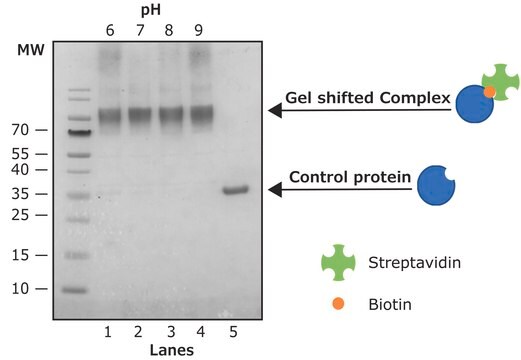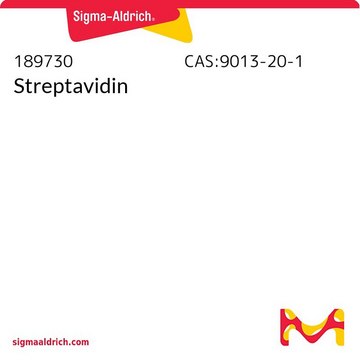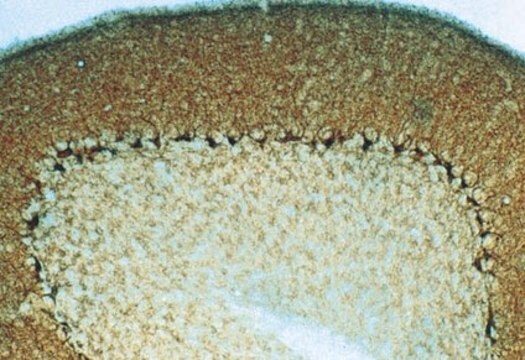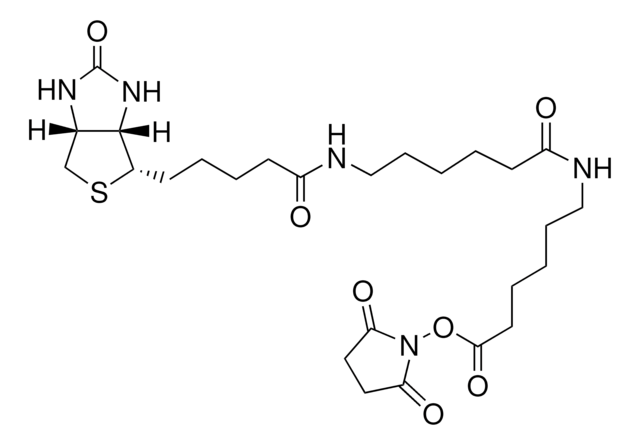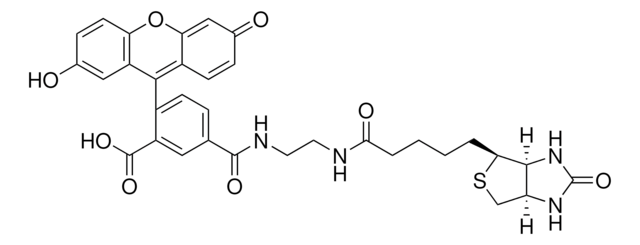BK101
ImmunoProbe™ Biotinylation Kit
Synonyme(s) :
Biotinylation Kits
Se connecterpour consulter vos tarifs contractuels et ceux de votre entreprise/organisme
About This Item
Code UNSPSC :
41116134
eCl@ss :
34058011
Nomenclature NACRES :
NA.32
Produits recommandés
Température de stockage
2-8°C
Niveau de qualité
Vous recherchez des produits similaires ? Visite Guide de comparaison des produits
Description générale
For custom biotinylation of proteins, Sigma offers kits for conjugation on two different scales. The biotin-avidin system has become popular when high sensitivity and specificity are desired. Biotin can be conjugated to antibodies, lectins, enzymes, and other proteins. The protocols in the kits have been optimized for antibodies. Avidin binds to biotin with a high affinity (Ka = 1015 M) and specificity. When conjugated to enzymes or fluorochromes avidin provides a means of identifying biotinylated compounds via enzymatic conversion of substrate to form a visible product or detection of fluorescence by spectrophotometry or flow cytometry.
Application
ImmunoProbe™ Biotinylation Kit has been used for preparation of biotin labeled antibodies.
Biotin has been modified with aminocaproate, then activated via an ester linkage with sulfo-N-hydroxysuccinimide (BAC-Sulfo-NHS). Aminocaproate provides a six-carbon spacer that reduces steric hindrance on the biotin and improves accessibility to the binding site on avidin. Sulfonation of the hydroxysuccinimide increases the polarity of the reagent, allowing it to dissolve easily in aqueous buffer. The ester provides a carbonyl carbon adjacent to a labile ester linkage as a target for primary amine side chains of accessible lysine residues, joining the biotinamidocaproate to the protein via an amide bond.
Caractéristiques et avantages
- Complete protocols for labeling and assay
- BAC-Sulfo-NHS is completely water soluble
- No DMF or DMSO needed
- Biotinylation occurs near neutral pH and physiological ionic strength, avoiding harsh conditions that could damage sensitive proteins
- Fast separation of conjugate from reactants using gel filtration
- 2-5 molar ratio biotin to protein in conjugate (for antibodies)
1 mg protein per reaction (B-TAG)
10 mg protein per reaction (BK-101)
• Sufficient reagents for at least 5 labelings
Conditionnement
Kit includes all reagents necessary for biotinylation and for determination of biotin/protein molar ratio.
Remarque sur l'analyse
Procedure:
Conjugation is performed in four easy steps:
1. Reconstitute BAC-Sulfo-NHS with Phosphate Buffer (PB).
2. Add BAC-Sulfo-NHS to protein and allow to react for 30 minutes at room temperature.
3. Separate the conjugate from the reactants on gel filtration.
4. Assay the conjugate for biotin incorporation by the avidin-HABA assay (BK-101 only). Conjugate is ready to use.
Conjugation is performed in four easy steps:
1. Reconstitute BAC-Sulfo-NHS with Phosphate Buffer (PB).
2. Add BAC-Sulfo-NHS to protein and allow to react for 30 minutes at room temperature.
3. Separate the conjugate from the reactants on gel filtration.
4. Assay the conjugate for biotin incorporation by the avidin-HABA assay (BK-101 only). Conjugate is ready to use.
Informations légales
ImmunoProbe is a trademark of Sigma-Aldrich Co. LLC
Mention d'avertissement
Danger
Mentions de danger
Conseils de prudence
Classification des risques
Eye Irrit. 2 - Resp. Sens. 1 - Skin Irrit. 2 - STOT SE 3
Organes cibles
Respiratory system
Code de la classe de stockage
10 - Combustible liquids
Faites votre choix parmi les versions les plus récentes :
Déjà en possession de ce produit ?
Retrouvez la documentation relative aux produits que vous avez récemment achetés dans la Bibliothèque de documents.
Les clients ont également consulté
Does the Sauerbrey equation hold true for binding of peptides and globular proteins to a QCM?: A systematic study of mass dependence of peptide and protein binding with a piezoelectric sensor.
Sohna JES and Cooper MA
Sensing and Bio-Sensing Research, 11, 71-77 (2016)
Establishment of a new immunological method for direct detection of Mycobacterium in solution
Hamzehlou S and Farajollahi MM
Journal of microbiology, immunology, and infection = Wei mian yu gan ran za zhi, 49(1), 97-103 (2016)
B Viart et al.
Bioinformatics (Oxford, England), 32(10), 1462-1470 (2016-01-21)
Antibodies are an important class of biological drugs, but with limitations, such as inadequate pharmacokinetics, adverse immunogenicity and high production costs. Synthetic peptides for the desired target represent an important alternative to antibodies. However, no computational tool exists to guide
Mixed self-assembled monolayer (mSAM) based impedimetric immunosensors for cardiac troponin I (cTnI) and soluble lectin-like oxidized low-density lipoprotein receptor-1 (sLOX-1)
Billah MDM, et al.
Sensors and Actuators B, Chemical, 173, 361-366 (2012)
Hao Chang et al.
Proceedings of the National Academy of Sciences of the United States of America, 109(12), 4455-4460 (2012-03-01)
Reversibly switchable fluorescent proteins (RSFPs) have attracted widespread interest for emerging techniques including repeated tracking of protein behavior and superresolution microscopy. Among the limited number of RSFPs available, only Dronpa is widely employed for most cell biology applications due to
Notre équipe de scientifiques dispose d'une expérience dans tous les secteurs de la recherche, notamment en sciences de la vie, science des matériaux, synthèse chimique, chromatographie, analyse et dans de nombreux autres domaines..
Contacter notre Service technique
